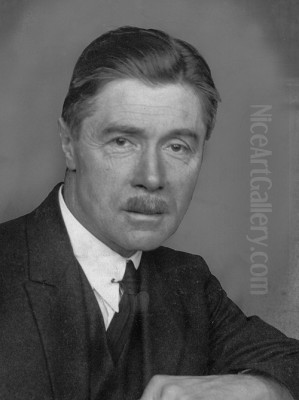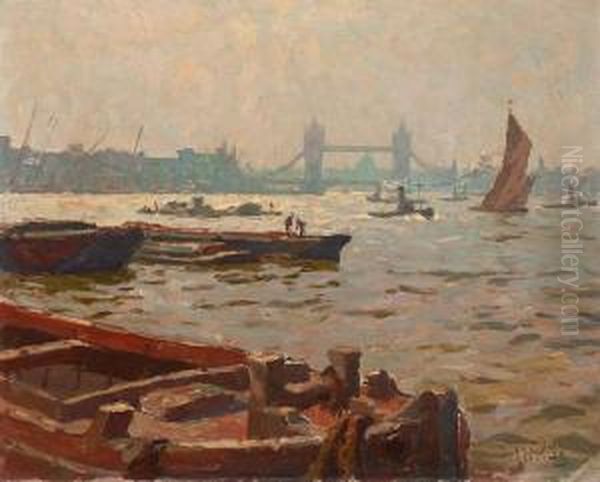
Hendrik Jan Wolter stands as a significant figure in Dutch art history, particularly noted for his vibrant contributions to Luminism, the Dutch variant of Neo-Impressionism. Spanning a career that bridged the late 19th and mid-20th centuries, Wolter navigated the evolving artistic landscape, moving from traditional Naturalism towards a modern exploration of light and colour, leaving behind a legacy of luminous cityscapes, bustling harbours, and intimate portraits.
Early Life and Artistic Awakening
Hendrik Jan Wolter was born in Amsterdam on July 15, 1873. His background was a blend of Dutch practicality and French heritage; his father was an engineer, while his mother hailed from a noble family in Normandy, France. This mix perhaps foreshadowed the artist's later ability to synthesize different cultural and artistic influences. The family later relocated to Amersfoort, where the young Wolter received his secondary education at the Hogereburgs School.
Initially, Wolter seemed destined for a different path. He embarked on training for a military career at a school in Haarlem. However, the rigid structure of military life proved incompatible with his burgeoning artistic inclinations. The call of the canvas was stronger than the call to arms, and Wolter made the pivotal decision to abandon his military pursuits and dedicate himself fully to the world of art. This change marked the true beginning of his lifelong engagement with visual expression.
Formative Years: Antwerp and Influences
Seeking formal artistic training, Wolter enrolled at the prestigious Royal Academy of Fine Arts in Antwerp, Belgium, in 1895. Antwerp, with its rich artistic history and vibrant contemporary scene, provided fertile ground for the young artist. During these formative years, his early work showed leanings towards Naturalism, a style prevalent at the time, often depicting scenes of everyday life, including workers and rural settings, with a focus on accurate representation.

However, the artistic currents flowing from France soon began to exert a powerful influence. Wolter became deeply impressed by the works of French Impressionists, particularly masters like Claude Monet and Pierre-Auguste Renoir. Their revolutionary approach to capturing fleeting moments, their emphasis on the effects of light, and their use of broken brushwork and a brighter palette resonated strongly with him. He also absorbed lessons from Camille Pissarro, known for his sensitive depictions of rural and urban life. This exposure marked a turning point, initiating a gradual shift away from the darker tones of Naturalism towards a more luminous and vibrant mode of expression.
Developing a Luminist Style
Wolter's artistic evolution did not stop with Impressionism. He became increasingly interested in the scientific and systematic approach to colour and light pioneered by the French Neo-Impressionists, or Pointillists, such as Georges Seurat and Paul Signac. While he did not rigidly adhere to the strict dot technique of Pointillism, he adapted its principles to develop his own distinct style within the Dutch Luminist movement.
Dutch Luminism, which flourished in the early 20th century, shared Neo-Impressionism's fascination with light but often employed short, distinct brushstrokes or patches of colour rather than uniform dots. Wolter embraced this approach, using dappled strokes and a high-keyed palette to capture the shimmering effects of sunlight on water, the vibrant atmosphere of city streets, and the subtle play of light across landscapes. His technique involved placing strokes of pure colour side-by-side, allowing the viewer's eye to blend them, creating an effect of exceptional vibrancy and luminosity. This became a hallmark of his mature style.
Subject Matter: Harbours, Cities, and Landscapes
Wolter's oeuvre is particularly celebrated for its depictions of water and urban life. He possessed a remarkable ability to capture the dynamic interplay of light, water, and architecture. Harbours were a recurring and beloved theme. He painted bustling port scenes in various locations, including the harbours of Zeeland in the Netherlands, the picturesque fishing villages of Cornwall in England, and potentially views of Bordeaux, France. These works often feature dazzling reflections on the water's surface, rendered with energetic brushwork and a keen sense of atmospheric perspective.
Cityscapes, especially views of Amsterdam, also feature prominently in his work. He painted iconic locations like the Rokin and various canals, capturing the unique character and light of the Dutch capital. His travels provided further inspiration; views of London, such as his depictions of Tower Bridge, and potentially other European cities like Bruges or Venice, showcase his ability to apply his Luminist technique to diverse urban environments. Beyond the city, he also painted landscapes, particularly scenes around the artists' village of Laren where he later settled, capturing the Dutch countryside with the same sensitivity to light and colour.
Life in Laren and Artistic Circles
In 1904, Wolter married Popkolk Koos van der Veen, who was herself an artist. They settled in Laren, a village in the Gooi region that had become a magnet for artists, initially attracting figures associated with the Hague School like Anton Mauve and Albert Neuhuys. While living in Laren, Wolter interacted with other resident artists, including Ferdinand Hart Nibbrig (a fellow Luminist), the modernist Jan Sluijters, and Co Breman. However, Wolter maintained a degree of independence, never fully becoming part of the established 'Laren School' aesthetic, instead pursuing his own Luminist path.
Wolter was an active participant in the Dutch art world. He was a member of the prestigious Amsterdam-based society "Arti et Amicitiae," a hub for artists and art lovers. Through Arti, he formed lasting friendships with figures like the architect K.P.C. de Bazel and the painter C.A. van Roggen, sharing with them an interest in architecture. He was also associated with the "Hollandsche Kunstenaarskring" (Dutch Artists' Circle), a group that sought to move beyond the perceived conservatism of traditional Dutch painting, alongside contemporaries like Piet van der Weyden and the influential modernist Leo Gestel.
His network of friends and colleagues included other notable artists such as Georg Rueter, the Orientalist painter and etcher Marius Bauer, Maria van Regteren Altena, and Coba Ritsema, one of the 'Amsterdam Joffers'. These connections highlight Wolter's integration within the vibrant artistic milieu of his time. His talent was recognized early on; in 1904, he received the Willink van Collen Prize, an important award for young artists in the Netherlands. Sources suggest Wolter possessed a sociable personality and a zest for life, traits which, while enriching his personal life, may have occasionally diverted time and energy from his artistic pursuits.
Travels and Broadening Horizons
Travel played a significant role in broadening Wolter's artistic horizons and subject matter. His time spent in Cornwall, England, resulted in some of his most celebrated harbour scenes, capturing the unique light and coastal life of the region. His depictions of London landmarks demonstrate his engagement with the bustling metropolis. Visits to Belgium and France were crucial for his absorption of Impressionist and Neo-Impressionist ideas.
Evidence suggests he may also have travelled to Italy, a common destination for artists seeking classical inspiration and picturesque landscapes. A later work titled Brooklyn Street, dated 1946, intriguingly suggests a possible visit to the United States late in his life, or perhaps work created from sketches or photographs. These journeys provided fresh perspectives and diverse motifs, enriching his Luminist explorations of light and atmosphere in different geographical contexts.
Later Career and Legacy
Hendrik Jan Wolter continued to paint actively throughout his life. Even during the difficult years of World War II, he reportedly continued to create works depicting coastal towns. His commitment to his art remained steadfast. He passed away in Amersfoort on October 29, 1952, leaving behind a substantial body of work.
In the context of Dutch art history, Wolter occupies an important position. He is recognized as one of the leading proponents of Dutch Luminism, skillfully adapting international trends like Impressionism and Neo-Impressionism into a distinctly Dutch sensibility. His work provides a vital link between the 19th-century traditions of the Hague School and Amsterdam Impressionism (represented by artists like George Hendrik Breitner and Isaac Israëls) and the burgeoning modernism of the early 20th century seen in the work of contemporaries like Sluijters and Gestel.
While perhaps not achieving the same level of international fame as some of his modernist colleagues, Wolter's reputation within the Netherlands is secure. His paintings are held in significant public collections, including the Singer Laren museum, which has a strong focus on artists connected to the Laren area. His works continue to be appreciated and sought after in the art market, with auction results reflecting sustained interest from collectors. A portrait like Gysberti Hodenpijl commanded significant estimates, and his landscapes and cityscapes remain popular for their vibrant beauty.
Representative Works Revisited
Several works exemplify Wolter's style and thematic concerns. His View of the Rokin, Amsterdam captures the bustling heart of the city with shimmering light on the canal and lively street activity, rendered in his characteristic broken brushwork. His Cornish harbour scenes, often depicting fishing boats and coastal villages under bright sunlight or hazy skies, are masterclasses in capturing atmospheric effects and the reflections on water.
Works like Tower Bridge, London show his ability to tackle iconic international landmarks with his Luminist approach. The late-career Brooklyn Street (1946), if accurately attributed and dated, offers a fascinating glimpse into his engagement with a vastly different urban environment. The Portrait of Gysberti Hodenpijl demonstrates his skill in portraiture, likely applying his understanding of light and colour to the human form, complementing his known studies of nudes and other figural work. Across these varied subjects, the consistent thread is his fascination with light and his ability to translate its effects into paint with vibrancy and sensitivity.
Conclusion
Hendrik Jan Wolter was more than just a painter of pleasant scenes; he was a dedicated explorer of light and colour, a key figure in the Dutch Luminist movement, and an artist who successfully navigated the transition from 19th-century realism to early 20th-century modern sensibilities. His ability to absorb international influences while retaining a personal vision, his mastery in depicting the interplay of light on water and architecture, and his active participation in the artistic life of his time solidify his place in Dutch art history. Through his luminous canvases, Wolter continues to offer viewers a vibrant and optimistic vision of the world, captured in strokes of brilliant colour.